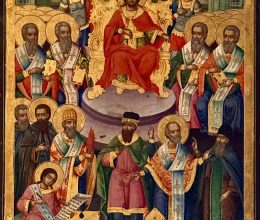The history of the Church should, in fact, be called the history of truth.
Blaise Pascal (1623 – 1662)
On May 9, 2022, His All-Holiness, the Ecumenical Patriarch Bartholomew, to the great joy of Orthodox believers here and across the Orthodox ecumene, healed the decades-long church schism and “received the hierarchy, clergy, and faithful of the Church led by Archbishop Stefan into Eucharistic unity,” recognizing it under its historical and ecclesiastically correct name—the Ohrid Archbishopric. This is a wonderful occasion to briefly recall the history of the ancient Ohrid Archbishopric, which has profoundly influenced all Orthodox peoples within its diocese and the wider Balkan region.
Created immediately after the fall of Samuil’s state, the ancient Ohrid Archbishopric gained its church-canonical legitimacy as an autocephalous church based on three chrysobulls issued by the Roman (Byzantine) Emperor Basil II, dated 1019 and 1020. Designating the city of Ohrid as its sole seat, for the next 800 years of its existence—until its abolition in 1767—it would become one of the most influential Orthodox local churches within the Byzantine Balkan commonwealth, second only to the Ecumenical Patriarchate in Constantinople.

A great connoisseur of the history of the Ohrid Archbishopric, Ohrid native Ivan Snegarov, in the preface to the second volume of his History of the Ohrid Archbishopric – Patriarchate, published in Sofia in 1932, wrote that the Ohrid Archbishopric is the fruit of the majestic tree planted by St. Clement of Ohrid during his missionary and episcopal work. Indeed, although its beginnings date more than 50 years after St. Clement’s death, the Ohrid Archbishopric has been a zealous guardian of the spiritual legacy of the saint, who is its spiritual patron and protector, throughout its existence. This was true in the time of the famous Archbishop Theophylact of Ohrid (11th–12th century), during the tenure of the even more renowned Archbishop Demetrios Chomatenos (13th century), and remains so to this day.

Sources indicate that during the time of the Samuil dynasty (976–1018), the city of Ohrid became the seat of an archbishopric. However, the true canonical legitimacy of the Ohrid Church was established in the early years of the full re-establishment of Roman rule in those territories. Through Emperor Basil II’s charters, its independent and autocephalous canonical status as an archbishopric was precisely regulated. The Byzantine sovereign, with great wisdom and vision, clearly defined the diocese, rights, and obligations of the newly formed archbishopric. This was the period when the Ohrid Archbishopric experienced its greatest flourishing in every respect.
Formed by imperial decree, the Ohrid Archbishopric functioned as a Roman institution, uniting within its diocese the various medieval ethnicities—all the peoples living within the Balkan region of its jurisdiction. It treated all equally, as its children, regardless of whether they were Slavic-speaking, Greek-speaking, Albanian-speaking, or others. In this, it faithfully followed the example and policy of its mother church, the Ecumenical Patriarchate, which adhered strictly to the New Testament principle that within the Church, there is no distinction between Jew and Greek (cf. Romans 10:12).

The best example of the close relations and unbreakable ties between the Ohrid Archbishopric and the Ecumenical Patriarchate in Constantinople is the fact that nearly all the archbishops of Ohrid, without exception, came from the ranks of the clergy of the Ecumenical Patriarchate. The same holds true for the high hierarchy of the Ohrid Archbishopric. Its essential connection to the Byzantine capital, the “Queen of Cities”—Constantinople—is further evidenced by the fact that the Roman emperor personally selected the future head from among three candidates proposed by the Synod of the Archbishopric. This practice remained in place until the Ottoman conquest.
After the fall of Constantinople and the conquest of the Byzantine Empire by the Crusaders in 1204, the Ohrid Archbishopric continued to exist as an autocephalous church. It retained its autocephalous status during the time of the Despotate of Epirus in the first half of the 13th century, as well as during the period when much of its diocese came under the Second Bulgarian Empire following the Battle of Klokotnitsa in 1230.

Even after the restoration of Byzantium in 1261, the Ohrid Archbishopric not only preserved its autocephaly but also regained the prestige and influence it enjoyed during the reign of Emperor Basil II and his successors. This status remained unchanged after the Serbian conquests of most of Byzantine Macedonia at the end of the 13th and beginning of the 14th century, though its diocese did shrink in favor of the Patriarchate of Peć.
Throughout its centuries-long history, especially before the Ottoman conquests in the Balkans, the boundaries of the Ohrid Archbishopric’s diocese continuously shifted, influenced by the political circumstances of the region. Various parts of its diocese were under different rulers at different times. Nevertheless, what is noteworthy is that its canonical status as an autocephalous church was never violated or challenged, either by the Ecumenical Patriarchate or by political authorities. The connections between ecclesiastical Constantinople and Ohrid continued to deepen and strengthen. Ohrid’s archbishops consistently recognized the primacy of the Ecumenical Patriarchate within the Orthodox ecumene, particularly in the Byzantine Balkan commonwealth. The Patriarchate, in turn, respected the hierarchy’s authority in Ohrid. Historical sources do not record any periods of schism between Constantinople and Ohrid, a rare distinction compared to other medieval local churches in the Balkans.

During its eight-century history, the Ohrid Archbishopric produced a large number of enlightened and prominent hierarchs. Among the most distinguished Ohrid archpastors, we first mention the first Archbishop, St. John of Debar (1018–1037), appointed to that position by Emperor Basil II. Then, we have the two exceedingly great Ohrid hierarchs: Theophylact of Ohrid (c. 1084–1107) and Demetrios Chomatianos (1216–1234). These figures, among other things, have left an indelible mark through their theological and hagiographic works, leaving behind numerous written pieces. Their works include interpretations of many complex canonical issues. Archbishop John was a well-known translator of theological and ascetic literature, while the blessed Theophylact and the learned Demetrios are the authors of the two hagiographies of St. Clement, thus being most responsible for the revival of his veneration among the flock of the Ohrid Archbishopric. Following them, we have Constantine Kabasilas (c. 1250), Makarios of Ohrid (late 13th – early 14th century), and others.
Интересен и мошне податлив за научен интерес е османлискиот период од историјата на Охридската Архиепископија. Тоа е времето на османлиското владеење на Балканот, сè до укинувањето на Архиепископијата во 1767 година. Па така, во првите два века под османлиска власт, на охридските архиепископи им биле потврдени старите и признаени дополнителни привилегии од страна на султаните. Во тоа време особено истакната улога имал Архиепископот Прохор Охридски (ок. 1528 – ок. 1550).
An intriguing and highly interesting period for scholarly inquiry is the Ottoman era of the Ohrid Archbishopric’s history. This is the period of Ottoman rule over the Balkans, lasting until the abolition of the Archbishopric in 1767. Thus, in the first two centuries under Ottoman rule, the archbishops of Ohrid had their old privileges confirmed and additional privileges recognized by the sultans. During this time, Archbishop Prochorus of Ohrid (c. 1528–c. 1550) played a particularly prominent role.

In this period, the excellent relations between the Ohrid Archbishopric and the Ecumenical Patriarchate also continued. The tradition of selecting the high hierarchy of Ohrid, including the election of the Archbishop of Ohrid from the ranks of the clergy of the Patriarchate in Constantinople, continued to be nurtured. Although almost all of the metropolitans of the Archbishopric were Greeks or Greek-speaking, it must be emphasized that they showed equal kindness to their entire flock, fairly and impartially, regardless of whether they were Slavic-speaking, Greek-speaking, Albanian-speaking, Vlachs, or other Orthodox populations. Thus, we can rightfully conclude that the Archbishopric of Ohrid, like the Ecumenical Patriarchate in Constantinople and the Patriarchate of Peć, were institutions most responsible for preserving the Orthodox identity in the Balkans.
By the 17th century, conditions began to change. Due to a series of internal political circumstances within the Ottoman Empire, many Orthodox churches and monasteries began to impoverish. The economic crisis and increasingly frequent political abuses by local Ottoman authorities led to many churches being looted and their ecclesiastical activity paralyzed. The archbishops and clergy of Ohrid began to face growing financial problems.
The material hardship of the Orthodox population under the jurisdiction of the Ohrid Archbishopric worsened further in the first half of the 18th century, caused by the economic crisis and the frequent unprincipled provocations by local authorities. The dioceses of the Archbishopric became impoverished to the point where they could no longer cover even the basic financial obligations. Debts kept mounting, including tax and other obligations to Ottoman institutions. The Patriarchate of Peć found itself in a similar situation. Under such conditions of financial inability to pay its debts to the Ottoman state, in 1766 and 1767, Sultan Mustafa III, in line with his strict fiscal policy, first abolished the Patriarchate of Peć and, a few months later, the Ohrid Archbishopric. Consequently, all of their dioceses were automatically placed under the jurisdiction of the Ecumenical Patriarchate, which practically remained the only influential Orthodox Church in the Ottoman Empire.

What we want to emphasize in this context is the origin of the historical narrative regarding the role of the Ecumenical Patriarchate in the Sultan’s decision to abolish the Ohrid Archbishopric, which does not differ significantly from the narrative regarding the abolition of the Patriarchate of Peć. In the 19th century, first in Western Europe and later in the Balkans, the phenomenon of nation formation began to emerge. Each of the then-young Balkan Slavic nations, particularly Serbia and Bulgaria, began to build their own national myths. These included politically constructed narratives about church affairs in the past, viewed through the lens of “us” versus “them.” These narratives gradually became entrenched in the Balkan national historiographies, and over time, they were rarely questioned.
Today, times are different. History as a modern scientific discipline has developed a strictly defined methodology for investigating historical processes, events, and figures. Every serious scholar must adhere to this methodology because only through such a process can we arrive at the objective historical truth, whose ultimate goal is the emancipation of society.

In the context of what has been said, we believe that scientific facts clearly indicate that the only reason for the abolition of the Ohrid Archbishopric in 1767 was the strict fiscal policy of Sultan Mustafa III and the Archbishopric’s inability to pay its significant debts to the Ottoman state. Speaking of hidden national agendas and denationalization policies in the 17th and 18th centuries is inappropriate, as nations had not yet appeared on the historical stage—neither in Western Europe nor in the Balkans.
What is also part of the objective historical truth is the fact that the Ohrid Archbishopric reached its zenith during the Byzantine epoch. This was the period when it encompassed almost the entire territory of the Roman dominions in the Balkans. Under its jurisdiction were the entire Slavic population, as well as parts of the Greek and Albanian Orthodox populations in the Balkans. Thus, the history of the Ohrid Archbishopric is not the exclusive part of any nation’s narrow history. On the contrary, it is perhaps one of the rare institutions that unites the histories of all the Orthodox Balkan peoples.

In conclusion, we end this brief review of the history of the Ohrid Archbishopric with a gospel quote: “And the rain fell, and the floods came, and the winds blew and beat on that house, but it did not fall, because it had been founded on the rock.” (Matthew 7:25). Likewise, His All-Holiness, Ecumenical Patriarch Bartholomew, healed the decades-long schism and placed the final stone in the restoration of the old-new Ohrid Archbishopric, to the joy of all well-meaning Orthodox believers, wherever they may be.
Prof. Dr. Dragan Zajkovski,
Church historian and medievalist















